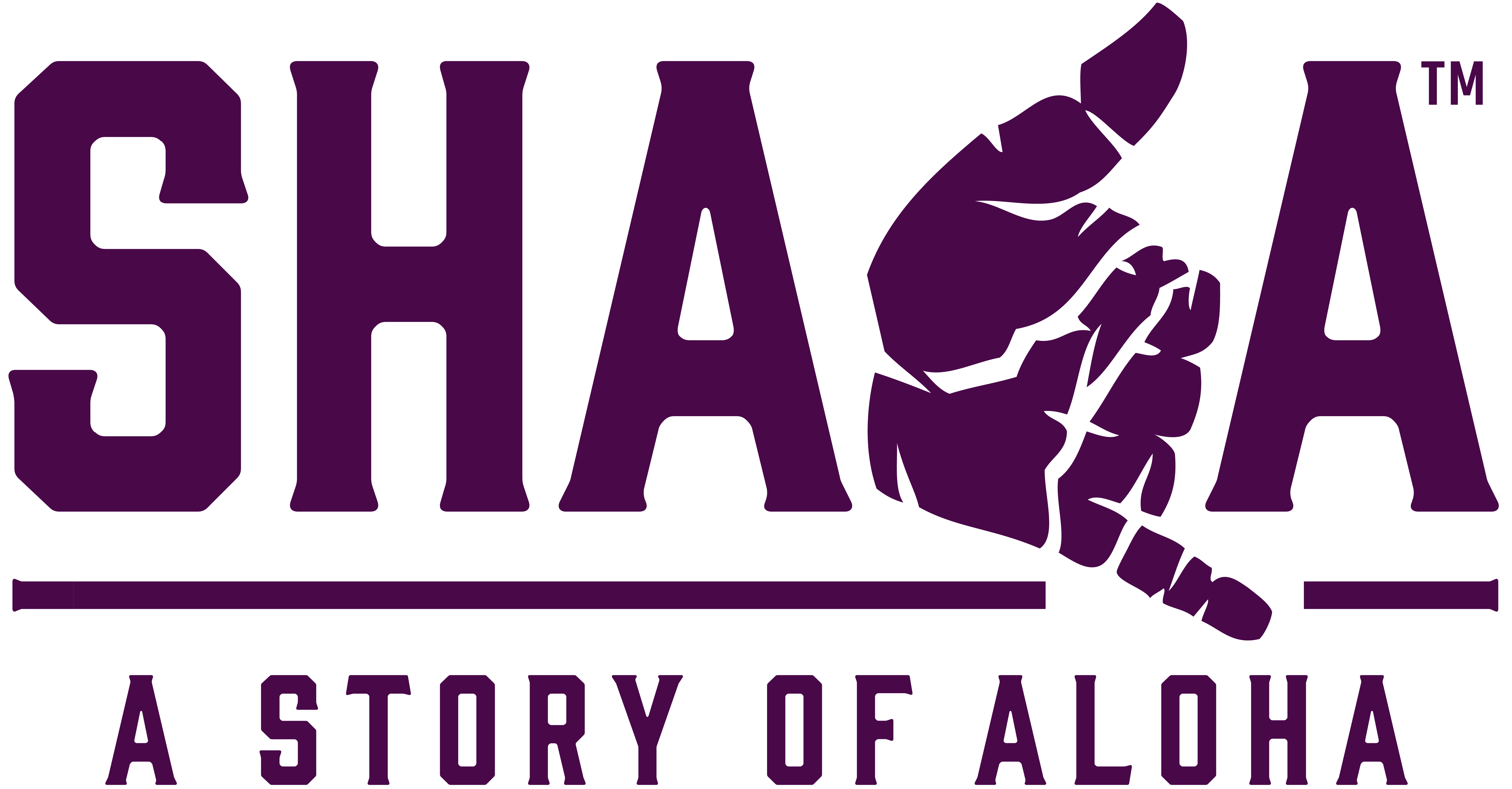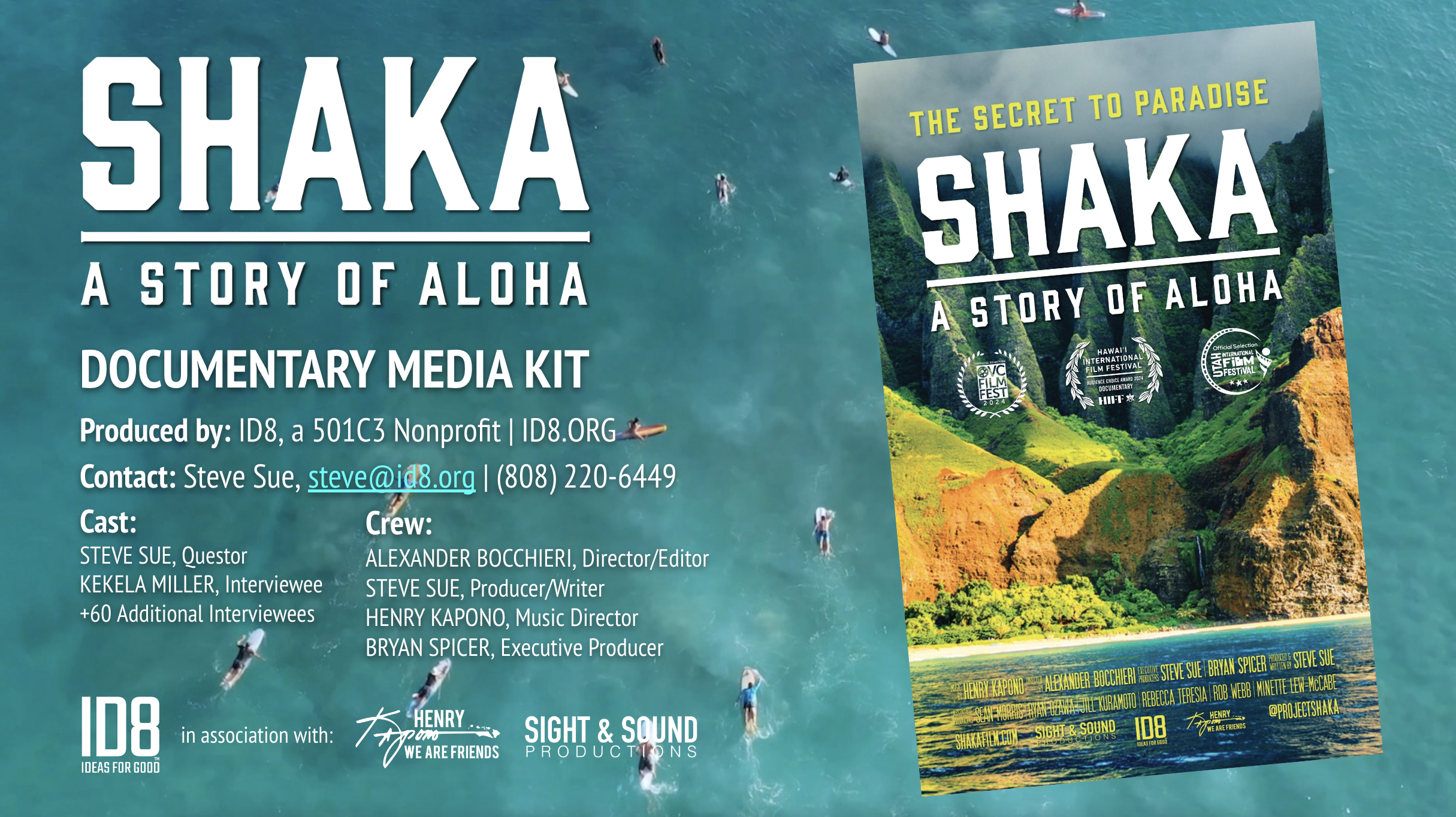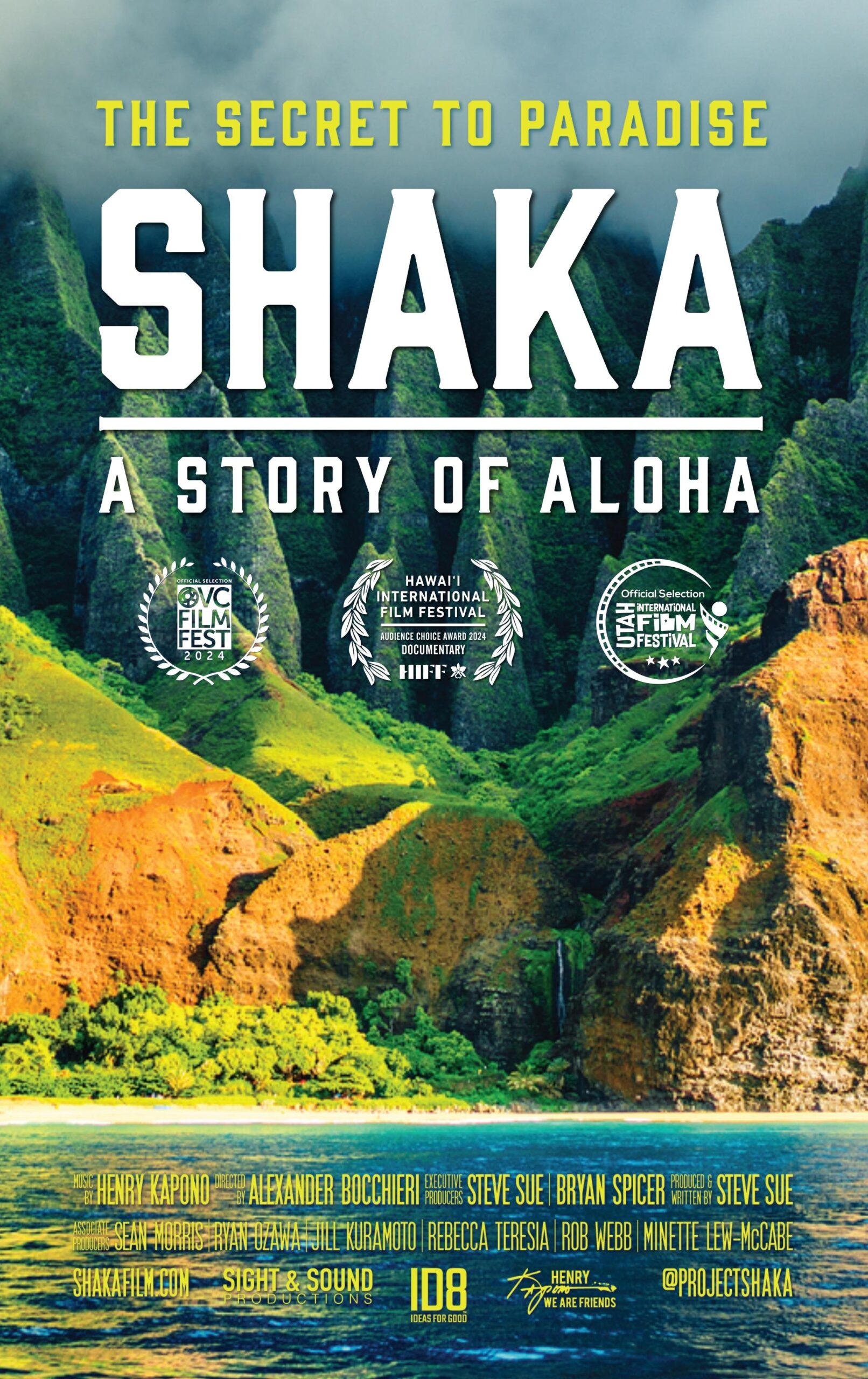Shaka Media Kit
The Secret to Paradise
“Shaka, A Story of Aloha” is an 80-minute feature-length global quest to unravel the mysteries of the Shaka gesture from Japan’s temples to Brazil’s waves to Hawaii’s white sandy beaches. Discover why it ignites pride in train-jumpers, surfers, and everyday adventurers alike, explore its origins and meanings, and learn how it holds the key to creating and preserving paradise.
Media Kit: Download PDF »
Media Contact: Steve Sue, producer/writer | steve[at]id8.org | (808) 220-6449 | @histevesue
Trailer
Logline
Aloha. Mahalo. Hang Loose! From Japan’s temples to Brazil’s beaches to Hawaii’s epic North Shore waves, embark on a global quest to unravel the mystery of the Shaka gesture. Discover why it ignites pride in train-jumpers, surfers and everyday adventurers alike. Experience 110 years of Shaka history as questor Steve Sue builds a “who dunnit” bulletin board for his Aunty Kela to reveal the gestureʻs origins, meanings and how it holds the secrets to creating and preserving paradise.
Summary
“Shaka, A Story of Aloha” delves into 110 years of Shaka history, as questor Steve Sue embarks on a journey to uncover the origins and meanings of the iconic gesture. Through the construction of a “who-dunnit” bulletin board for his Aunty Kela, Sue reveals how the Shaka holds the keys to both creating and preserving paradise. The story opens in the green room of a Shaka contest, where contestants grapple with the essential question: What is the authentic way to throw a Shaka?
To answer this, the film traces the Shaka’s evolution across time, from its appearance in the 1997 Miss Universe contest with Brook Lee, to its use by General Kenneth Hara’s Shaka Battalion in Iraq, the Hang Loose brand in Brazil, and its presence in surfing, sports, journalism, and entertainment. The journey also explores how the gesture connects to sugarcane plantation workers, train jumpers, a Waikiki used car salesman, a Honolulu Mayor, and even the Church of Jesus Christ of Latter-day Saints.
In examining the Shaka’s origins, the film considers various theories, from links to Shaka Zulu, Portuguese drinking traditions, and Japanese Buddhism, to a leprosy colony in Hawaii. The narrative circles back to the Shaka Contest, showcasing the gesture’s diverse applications and ultimately revealing it as a symbol of Aloha and the secret to sustaining paradise.
In the closing credits, an epilogue introduces “Project Shaka,” a nonprofit initiative dedicated to spreading Aloha through the Shaka gesture.
Synopsis
Shaka, A Story of Aloha investigates the origins, history, and meanings of the iconic Shaka gesture. The film opens with surfers throwing Shakas and questioning where it came from, leading to a Green Room scene at a Shaka Contest that frames the challenges of using it authentically.
As contestants nervously take to the stage, the action cuts to the North Shore town of Lā’ie, O’ahu, where questor Steve Sue meets with key interviewee Aunty Kekela Miller to present and discuss his findings from a 5-year journey to discover the secrets of the Shaka. Steve begins a backward journey in time, showing Aunty Kekela a trove of archival evidence on various use and origin stories of the Shaka. Stepping back in time lends to trumping origin stories with earlier stories, starting from use by Miss Universe BROOK LEE and KEN HARA’s Shaka Battalion in Iraq. The story continues backward in time presenting uses in local news, surfing, extreme sports, journalism, politics, entertainment including ELVIS PRESLEY, Japanese Buddhism, possible connections to Shaka Zulu, marbles players, Portuguese drinking, a leprosy colony on Moloka’i Island, and a 1906 schoolboy photograph.
The final origin story tells the tale of HAMANA KALILI, a legendary North Shore sugarcane worker, master fisherman and role model, who after a debilitating accident at the Kahuku Sugar Mill, became a security guard on a North Shore sugarcane train that kids including Aunty Kekela jumped by using the Shaka gesture. The scene continues with a myriad of archival evidence that establishes Hamana as a hero and greatly-respected modern-day King. In his later years, he was the organizer of the Lā’ie Hukilau (a whole-town net fishing experience) which ran from 1948 to 1963 at which tie the Polynesian Cultural Center was opened to take the place of the Hukilau. After a 60-year absence, the Lā’ie Hukilau was re-mounted for a one-time event with over 1,000 participants and was captured for this film.
Presented as a light-hearted “who dunnit,” the film features a recurring “crime board” scene in which questor STEVE SUE pieces together the Shaka’s history for key interviewee KEKELA MILLER. The film concludes back at the Shaka Contest, illustrating a myriad of Shakas for various contexts and delivers how the Shaka is the secret to creating and maintaining paradise anywhere in the world. An Epilogue throughout the End Credits illustrates how the film has birthed “Project Shaka,” a nonprofit movement dedicated to sharing Aloha through the Shaka.
Backstory
Says producer/writer Steve Sue, “Our original goal was to produce a 20-minute short for classroom use but the story turned out to be bigger than anyone could have imagined. In the end, we discovered the Shakaʻs magic and how itʻs the secret to creating and maintaining paradise.” He continues, “If you want to know how to throw a truly legit Shaka or how to create paradise in your corner of the world, watch this film.”
The film is slated for late 2024 distribution, hopefully on streaming channels and possibly in cinemas. It has been in production since 2019 when first-funding and cultural experts were provided by Kamehameha Schools. During production, the COVID Pandemic forced a 2-year hiatus, but the project continued in 2022 with epic shots including the one-time running of an authentic Hukilau expedition that had not run in 60 years and the worldʻs first-ever Shaka Contest.
Through the production, it became clear that there are many origin stories, thus multiple theories are presented in the film, allowing audiences to decide which theory they find most credible. Says Sue, “The titling of the film as ‘A Story…’ represents only our group’s intent to present multiple origin stories, as several origin stories have evidence and testimony available. This leaves room for each audience member to decide for themself which story they favor as well as for other storytellers to present their own versions of the story.” Sue continues, “The more important thing for our team is providing a deep understanding of the meaning of it and how it can be used to share aloha and create paradise around the world.”
While the film was originally intended as a non-profit education piece, there are now prospects for it to be distributed in public entertainment channels. Says Sue, “There are no investors to the film and none of us as producers own any part of it, so any distribution proceeds will go to our non-profit to support Shaka-based programs that benefit Hawai’i and the world beyond.”
A Growing Movement
Even before release of the film, the publicʻs appetite for the story has resulted in several Shaka-based programs, now recognized as Project Shaka, a movement that includes the documentary, a free Shaka Decal program, a Hawai’i State Bill to recognize the Shaka as the official Hawai’i State Gesture (authored by Steve Sue, filed by Senator Glenn Wakai and Representative Sean Quinlan, signed into law by Gov Green, 2024), an official Hawai’i State DMV Shaka License Plate (went live 2024), and curriculum models that teach the values and uses of the Shaka. See projectshaka.com »
For more, see Filmmaker’s Statement »
Production Team
The film is produced by ID8 (ide•ate), a Hawai’i 501C3 nonprofit organization. Top-level producers/artists include Exec Producer/Producer/Writer Steve Sue, Executive Producer Bryan Spicer (director/producer Hawaii-Five-O, Magnum PI), Grammy-nominated Music Director Henry Kapono and Director/Editor Alexander Bocchieri. Associate Producers Sean Morris, Jill Kuramoto, Ryan Ozawa, Rob Webb, Rebecca Teresia, Minette Lew-McCabe. Cultural Advisors include Robert “Lono” Ikuwe, Manu Boyd and Hailama Farden.
Poster:
Utilizing Hawai’i Talent
The production team (paid living wages) is built from local talent from the University of Hawai’i at Manoa Academy of Creative Media Program. These include native Hawaiian Director Alex Bocchieri, Cinematographer Kristle Backe, Co-Editor Shaun Oliqiano, Assistant Editor Sara Brekke and Coordinator Eve Ordinario. Dozens of additional locals served on the production and post-production teams.
60+ Expert Interviews
Many ask “who’s in the film?” Credibility counts as does factual evidence. We’ve treated this project like a court case, presenting direct testimony. Over a 5-year period, we conducted 60+ interviews including Joel “Baldy” Apuakehau, Charles Bargas, Todd Bradley, Cy Bridges, Renee Cabrinha, Ian Cairnes, Wally Camp, Jack Cione, Kathy Collins, Benjamin Dela Cruz, Frank Delima Jr., David Espinda, Joyce Fasi, Charles Fasi, Mike Foley, Victor Foniomoana, Gen. Kenneth Hara, Karl “Kini Popo” Hebenstreit, Fred Hemmings, Robert “Lono” Ikuwa, Mona Kahawaii, Henry Kapono, John “Keoni” Kauwe III, “Unko” George Kahumoku, Maria Latu, Brook Lee, Jeff Livingston, Vonn Logan, Kekela Miller, Riley Moffat, Jon Nouchi, Vernal Pratt, Harold Pukahi, Laverne Pukahi, Bill Sharp, Bob Sigall, Bryan Suzuki, Lanai Tabura, Willa Tanabe, George Tanabe, Rev. Ryoso Toshima, Peter Townend, Paul Udell, Caroline Vargas, Michael Victorino, Isaiah Walker, Moana Jones Wong.
Media Contact: Email Steve Sue »
Project Shaka Movement
“Shaka, A Story of Aloha” is the initial program and anchor of the Project Shaka, a movement to share aloha through the Shaka. The movement features multiple programs including:
- The “Shaka, A Story of Aloha” documentary.
- Free Shaka Stickers Program.
- Official Hawai’i DMV Shaka License Plate Program (became available to all Hawai’i State residents, May, 2024 on all Hawaiian Islands).
- Shaka Curriculum, (in development in partnership with Choosen Love Movement under grant form Hawai’i Department of Education due for release in Fall 2024).
- Shaka Gesture adopted as Hawaiiʻs Official State Gesture (the first official state gesture in America, adopted June, 2024).
- Shaka Emoji Application (the commonly used emoji for Shaka is “Call Me”)
- Shaka Monuments (in development as driected by the Shaka Gesture Law).
- Shaka Product Collaborations
Social Connects
Follow the project or find story assets:
-
- Official Websites: https://shakafilm.com
https://projectshaka.com - Facebook: @project.shaka, @histevesue
- X: @project_shaka, @histevesue
- Instagram: @projectshaka, @histevesue
- LinkedIn: @projectshaka, @histevesue
- YouTube: @projectshaka
- Hashtags: #shareashaka #projectshaka
- Official Websites: https://shakafilm.com
Intended Uses
COMMERCIAL DISTRIBUTION: Seeking cinematic, online streaming and broadcast screenings to share the film’s message with the world.
EDUCATION: The film is designed to teach modern era Hawai’i history, virtues and values. Curriculum and workshop models are in development.
FAQs
- How did the project get started? Producer/writer Steve Sue had a passing curiosity on the origin of the Shaka and was referred to Aunty Kela Miller of Lā’ie who asked him to capture her first-hand story for future generations.
- How can it be seen? While the film was made for educational use, public demand has resulted in an openness to consider commercial release. Ideally, a distributor will make the film available in late 2024 or Spring 2025.
- Who is in it? The film is a quest by Steve Sue and key interviewee Kekela Miller with scenes featuring 60+ interviewees.
- How long is it? “Shaka, A Story of Aloha” is an 80 minute feature-length film. It is anticipated that educational use will likely feature excerpt scenes used as ice-breaker intros for classroom lessons and exercises on the themes presented in the film.
- What is Project Shaka? The film has birthed a nonprofit movement and acts as an “operating system” for additional nonprofit programs that share aloha through the Shaka. Programs include free Shaka Stickers, Hawai’i DMV Shaka License Plates, a monument-building program, and educational curriculum.
Technical Info
- Type: Documentary
- Shooting Format: UHD 4K, Digital
- Aspect Ratio: 16×9
- Audio Format: Stereo
- Length: 80 minutes
- Original Language: English (US)
Project Shaka
SHARE ALOHA THROUGH THE SHAKA



